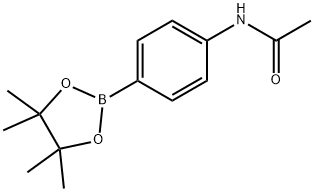3-Acetamidophenylboronic acid
Synonym(s):3-Acetamidobenzeneboronic acid
- CAS NO.:78887-39-5
- Empirical Formula: C8H10BNO3
- Molecular Weight: 178.98
- MDL number: MFCD00236013
- SAFETY DATA SHEET (SDS)
- Update Date: 2024-12-18 14:08:57

What is 3-Acetamidophenylboronic acid?
Chemical properties
Off-white to pale brown powder
The Uses of 3-Acetamidophenylboronic acid
suzuki reaction
The Uses of 3-Acetamidophenylboronic acid
Reactant involved in:
- Suzuki-Miyaura coupling reactions
- Trifluoromethylation
Reactant involved in the synthesis of a variety of inhibitors including:
- NR2B subtype of NMDA receptor antagonists for antidepressant activity
- Biphenylylmethylimidazole derivatives for use as 17,20-lyase inhibitors
- (Indolyl)-3,5-substituted benzene analogs with antimitotic and antitumor activity
- Substituted pyrrolidines and tetrahydrofurans as AMPA receptor positive modulators
Properties of 3-Acetamidophenylboronic acid
| Melting point: | 135 °C (lit.) |
| Density | 1.23±0.1 g/cm3(Predicted) |
| storage temp. | Keep in dark place,Sealed in dry,Room Temperature |
| solubility | soluble in Methanol |
| form | powder |
| pka | 8.04±0.10(Predicted) |
| color | Light orange to Yellow to Green |
| BRN | 3278316 |
| CAS DataBase Reference | 78887-39-5(CAS DataBase Reference) |
| EPA Substance Registry System | Boronic acid, B-[3-(acetylamino)phenyl]- (78887-39-5) |
Safety information for 3-Acetamidophenylboronic acid
| Signal word | Warning |
| Pictogram(s) |
 Exclamation Mark Irritant GHS07 |
| GHS Hazard Statements |
H315:Skin corrosion/irritation H319:Serious eye damage/eye irritation H335:Specific target organ toxicity, single exposure;Respiratory tract irritation |
| Precautionary Statement Codes |
P261:Avoid breathing dust/fume/gas/mist/vapours/spray. P264:Wash hands thoroughly after handling. P264:Wash skin thouroughly after handling. P280:Wear protective gloves/protective clothing/eye protection/face protection. P304+P340:IF INHALED: Remove victim to fresh air and Keep at rest in a position comfortable for breathing. P305+P351+P338:IF IN EYES: Rinse cautiously with water for several minutes. Remove contact lenses, if present and easy to do. Continuerinsing. P405:Store locked up. |
Computed Descriptors for 3-Acetamidophenylboronic acid
New Products
(S)-3-Aminobutanenitrile hydrochloride 4-Methylphenylacetic acid N-Boc-D-alaninol N-BOC-D/L-ALANINOL Tert-butyl bis(2-chloroethyl)carbamate 3-Morpholino-1-(4-nitrophenyl)-5,6-dihydropyridin- 2(1H)-one Furan-2,5-Dicarboxylic Acid Tropic acid 1-Bromo-3,5-Di-Tert-Butylbenzene S-2-CHLORO PROPIONIC ACID ETHYL ISOCYANOACETATE 2-Bromo-1,3-Bis(Dimethylamino)Trimethinium Hexafluorophosphate 4-IODO BENZOIC ACID 3-NITRO-2-METHYL ANILINE 1-(2,4-DICHLOROPHENYL) ETHANAMINE (2-Hydroxyphenyl)acetonitrile 4-Bromopyrazole 2-(Cyanocyclohexyl)acetic acid 4-methoxy-3,5-dinitropyridine 1-(4-(aminomethyl)benzyl)urea hydrochloride 2-aminopropyl benzoate hydrochloride diethyl 2-(2-((tertbutoxycarbonyl)amino) ethyl)malonate tert-butyl 4- (ureidomethyl)benzylcarbamate Ethyl-2-chloro((4-methoxyphenyl)hydrazono)acetateRelated products of tetrahydrofuran








You may like
-
 3-Acetamidophenylboronic Acid (contains varying amounts of Anhydride) CAS 78887-39-5View Details
3-Acetamidophenylboronic Acid (contains varying amounts of Anhydride) CAS 78887-39-5View Details
78887-39-5 -
 3-Acetamidobenzeneboronic acid CAS 78887-39-5View Details
3-Acetamidobenzeneboronic acid CAS 78887-39-5View Details
78887-39-5 -
 3-Acetamidophenylboronic acid CAS 78887-39-5View Details
3-Acetamidophenylboronic acid CAS 78887-39-5View Details
78887-39-5 -
 1975-50-4 98%View Details
1975-50-4 98%View Details
1975-50-4 -
 2-HYDROXY BENZYL ALCOHOL 98%View Details
2-HYDROXY BENZYL ALCOHOL 98%View Details
90-01-7 -
 2-Chloro-1,3-Bis(Dimethylamino)Trimethinium Hexafluorophosphate 221615-75-4 98%View Details
2-Chloro-1,3-Bis(Dimethylamino)Trimethinium Hexafluorophosphate 221615-75-4 98%View Details
221615-75-4 -
 14714-50-2 (2-Hydroxyphenyl)acetonitrile 98+View Details
14714-50-2 (2-Hydroxyphenyl)acetonitrile 98+View Details
14714-50-2 -
 118753-70-1 98+View Details
118753-70-1 98+View Details
118753-70-1
Statement: All products displayed on this website are only used for non medical purposes such as industrial applications or scientific research, and cannot be used for clinical diagnosis or treatment of humans or animals. They are not medicinal or edible.